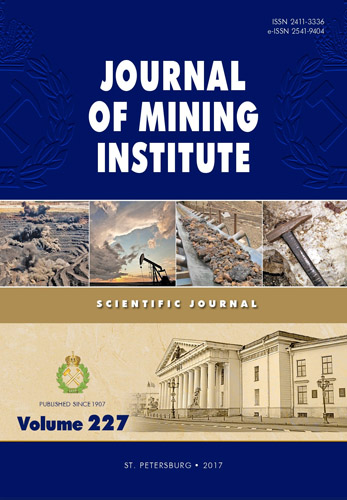Production of flat parts from foam aluminum in alternating magnetic field
- Ph.D., Dr.Sci. Head of Department Saint-Petersburg Mining University
Abstract
The electromagnetic technology for production of ultralight panels of materials based on foam aluminum is investigated. The theory of the interaction of the electromagnetic field with matter in the solid-liquid state and the formation of its corresponding distribution in space and time for the implementation of new technologies and equipment are considered. The suggested technology for the production of ultralight panels of materials based on foam aluminum include the following main stages: loading of powdered raw materials; preparation of the blank and the formation of the container; compacting (consolidation) by hot rolling; foaming of the preform precursor; production of a marketable product. The most difficult task is the process of heating the precursor to the temperature of foaming. In the course of the research, two possible modes of blank heating – static and periodic with reciprocating motion – were considered. The requirements for ensuring the temperature field of heated blanks for the production of foam aluminum are presented. The determining factor in the selection of the heating mode is the criterion for the quality of the blank heating. The main parameters that provide the required temperature field are the selection of the blank heating mode; speed of workpiece movement, and frequency selection. The displacement amplitude for reciprocating motion was chosen based on the available theoretical and practical experience of heating in this mode. The choice of frequency was influenced by several parameters, such as efficiency, voltage and current of the inductor, and its reactive power. The optimization of the process of electromagnetic processing of flat products on the basis of foam aluminum according to the results of numerical simulation makes it possible to develop an electromagnetic system for influencing metals in the solid-liquid state.
References
- Bokshtein S., Ginzburg S.S., Kishkin S.T., Razumovskii I.M., Stroganov G.B. Autoradiography of interfaces and structural stability of alloys. Мoscow: Metallurgiya. 1987, p.272 (in Russian).
- Belov A.F. New metallurgical processes – a way to improvement of quality and efficiency of use of metals. Izvestiya ANSSSR. Metally. 1981. N3, p.4-9 (in Russian).
- Beresnev A.G., Logacheva A.I., Logunov A.V. Problems and the prospects of application of metallurgy of granules for missile and space equipment. Dvigatel'. 2008. N2 (56), p.8-10 (in Russian).
- Garibov G.S., Eliseev Yu., Gol'dinskii E. Metallurgy potential granules. Natsional'naya metallurgiya. 2001. N1, p.34-36 (in Russian).
- Garibov G.S. Metallurgy of granules – a basis of creation of perspective aviation engines. Tekhnologiya legkikh splavov. 2007. N1, p.66-78 (in Russian).
- Demidovich V.B., Chmilenko F.V. Computer modeling of devices of induction heating. St.Petersburg: Izd-vo SPbGETU «LETI», 2013, p.160 (in Russian).7.NemkovV.S., DemidovichV.B. Theory and calculation of devices of induction heating. Leningrad: Energoatomizdat, 1988, p.280 (in Russian).
- Ponomarev Yu.I., Kiste N.V., Klyatskin A.S., Mel'nikov N.A. Processing of light and special alloys. Мoscow: VILS, 1996, p.419 (in Russian).
- Garibov G.S., Sizova R.N., Nozhnitskii Yu.A., Boguslavskii L.S. The prospects of production of aerospace materials and processes of their handling at the beginning of the 21st century. Tekhnologiya legkikh splavov. 2002. N4, p.106-117 (in Russian).
- Portnaya Z.N. Warm compaction of powder materials. Tekhnologiya metallov. 2003. N3, p.44-45 (in Russian).
- Rastvorova I.I. Use of induction heating in the production technology of metal products by a tiksoformovka method. Energoeffektivnye elektrotekhnologii: Sb. trudov. St.Petersburg: Izd-vo SPbGETU «LETI», 2011, p.55-57 (in Russian).
- Demidovich V.B., Grigor'ev E.A., Olenin V.A. et al. Energy-saving technologies of precision heating of light alloys in inductors. Aktual'nye problemy induktsionnogo nagreva (APIH-09). St.Petersburg: Izd-vo SPbGETU «LETI», 2009, p.31-39 (in Russian).
- Demidovich V. Computer simulation and optimal designing of energy-saving technologies of the induction heating of metals. Thermal Engineering. 2012. Vol.59. N14, p.1023-1034.
- Demidovitch V., Nikitin B., Olenin V. Induction installations for heating long cylindrical billets before metal forming. Russian Metallurgy. 2007. N8, p.98-102.
- Demidovitch V., Rastvorova I. Precise induction heating of non-ferrous cylindrical billet. Asian Journal of Applied Sciences. 2013. Vol.2. N3, p.310-317.
- Demidovitch V., Rastvorova I., Olenin V. Precise induction heating of Ti and Zr billets. Heat Processing. 2011. N3, p.266-270.
- Jae Chan C., Hyung Jin P., Byung Min K. The influence of induction heating on the microstructure of A356 for semi-solid forging. Journal of Materials Processing Technology. 1999. Vol.87, р.46-52.
- Jung H., Kang C. Induction heating process of an Al-Si aluminum alloy for semi-solid casting and its resulting microstructure. Journal of Materials Processing Technology. 2002. Vol.120, p.355-364.
- Jung H. The induction heating process of semi-solid aluminium alloys for thixoforming and theirmicrostructure evaluation. Journal of Materials Processing Technology. 2000. Vol.105, p.176-190.
